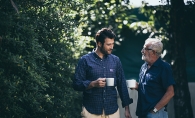Orienteering is a sport well-suited for those who like to get “off the beaten path.” Also referred to as “the thinking sport,” orienteering involves using a map and compass to find the best route through a series of checkpoints on an unfamiliar course.
Volunteers from the Minnesota Orienteering Club present clinics throughout the spring and summer in the metro. Last month, they held a clinic at French Regional Park, which included a class on map and compass skills, and then an opportunity to use those skills on guided courses designed for beginner and advanced levels.
At a typical clinic or orienteering gathering, along with a guided course, there is also an official “sprint” course, with electronic punching (a method of recording times).
At an orienteering event, a specialized, topographic map is used to choose the best route in a series of designated land features (the control points), spaced several hundred meters apart. Finding the control points depends on the individual’s ability to understand the map and relate it to the surrounding terrain, according to Molly Moilanen, one of the volunteers from Minnesota Orienteering who helps run the group’s clinics and classes.
Moilanen, a long-time marathon runner, was introduced to the sport about 10 years ago and found she loved it “because it combines the physical activity along with a mental challenge, and it gets you off the road and into the woods. It’s been a great way to explore the local parks.”
People unfamiliar with the sport often think it involves a compass, but that’s not the case, Moilanen says. It’s mainly about learning to read a highly detailed topographic map showing major features like trails and hills, but also details as small as boulders or individual trees, and finding the shortest path to navigate from point to point.
Orienteering courses are ranked by difficulty, based on their distances. There are three levels of difficulty: one to two kilometers, three to six kilometers and longer courses, which are typically around 10 kilometers in length.
The sport of orienteering is more popular in Europe and Scandinavia than in the United States, Moilanen says. “If you go to a city meet in Sweden, a thousand people will show up. It’s a sport they learn early on, like a part of gym class. So, when we compete internationally, Americans are at a disadvantage.”
Beginner classes usually feature short courses of two kilometers or less “so that everyone can use them as an entry point to learn the basics,” Moilanen says. “Someone who has never done it before can go to the classroom session, learn the basics and then go out with a small group, with one-on-one coaching provided.”
Participants can complete one course with a group, cover a longer course on their own and, if they choose, try a timed course of the type used for orienteering competitions.
Electronic punching is a relatively new feature, only used within the past six or seven years, according to Moilanen. Participants wear a small electronic device on one finger —about the size of a USB thumb drive—and an electronic checkpoint records the time of arrival at each station.
Adding to the appeal of orienteering is that it can also be a lifetime sport, Moilenan points out. “As you get older, if you don’t want to run, you can hike. And you can do it with the family. People come up with very different approaches and goals, depending on what they want to get out of it.”
Participants sometimes get so engrossed in the map-reading aspect, they forget they are also getting great exercise in the process.
For those who haven’t been taught to read a topographical map, a beginner clinic will “hopefully provide a foundation for folks and spark an interest to come out to a regular orienteering meet down the road,” she says.
&
To find an orienteering clinic or class near you this summer, visit threeriversparks.org or mnoc.org.









